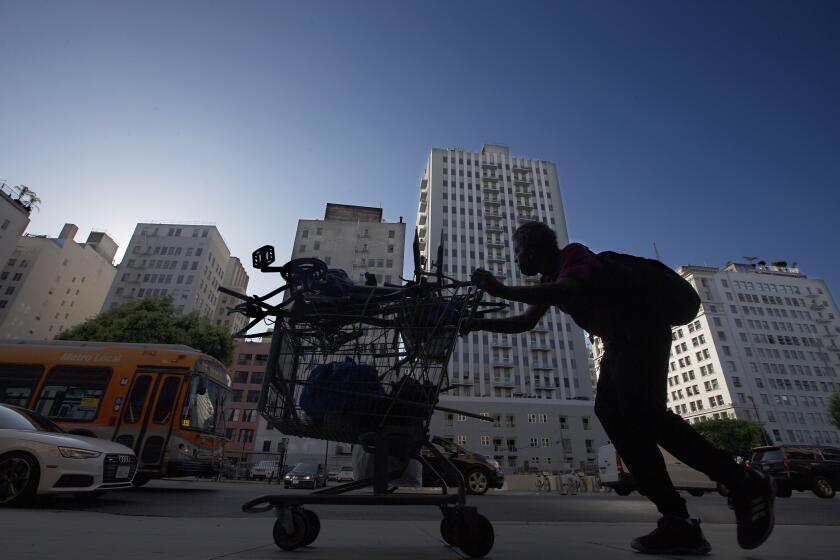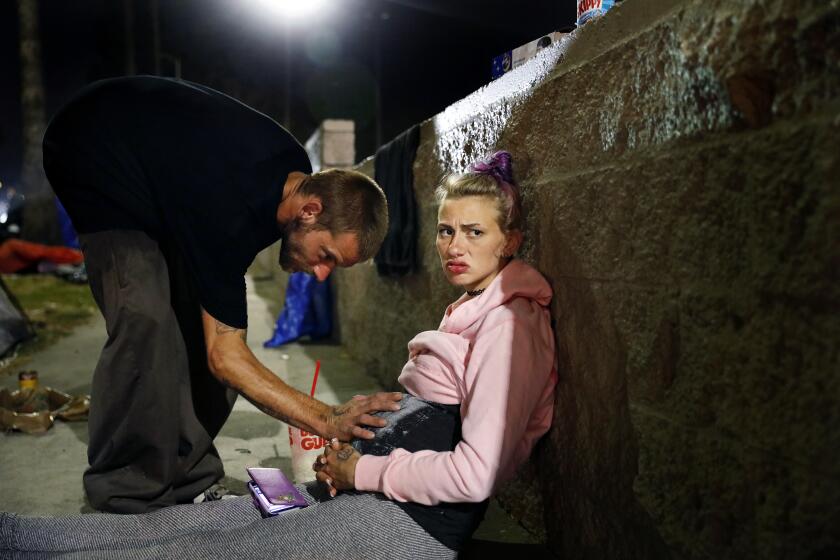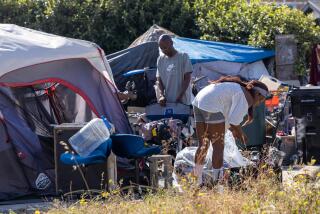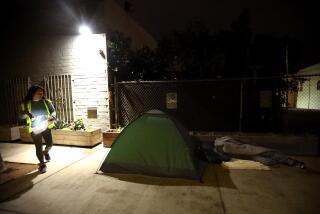Editorial: Want to fix homelessness in Los Angeles? The pandemic showed us how to do it
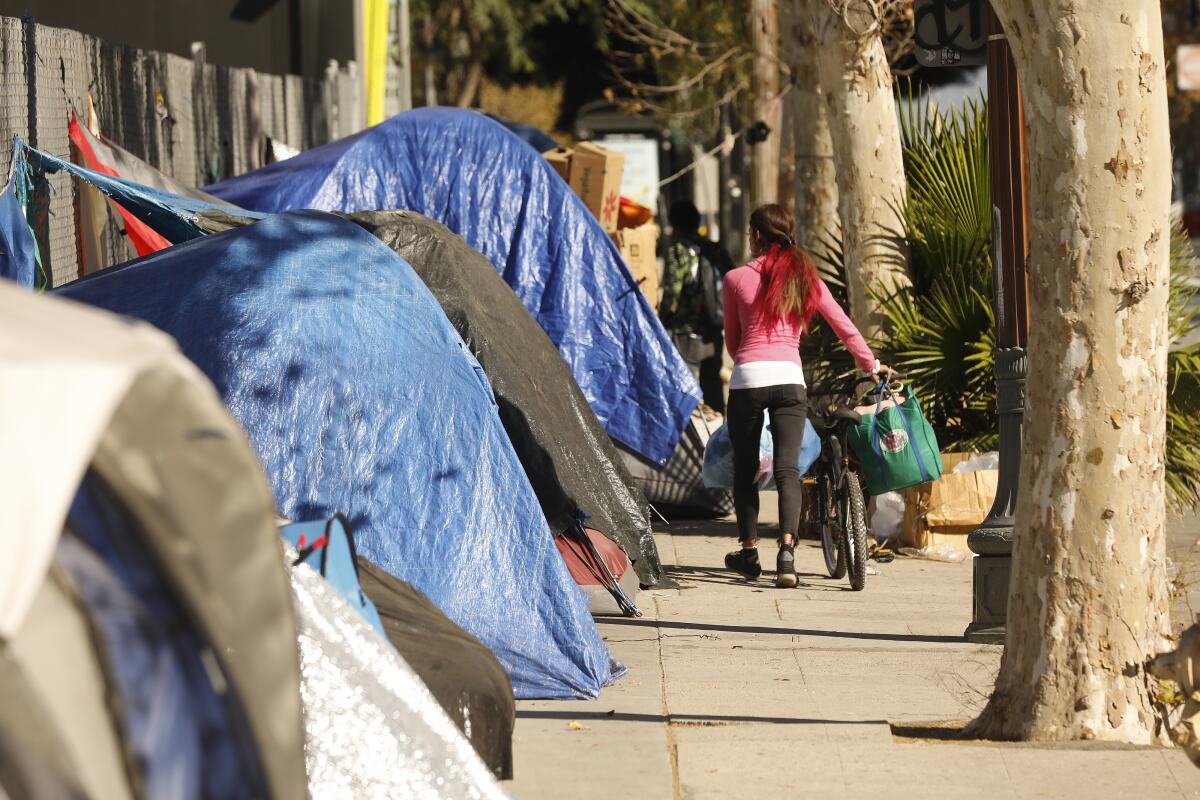
- Share via
For two years, the county of Los Angeles postponed its annual count of the homeless population due to concerns about COVID. In the absence of any data, many worried that the proliferation of tents on sidewalks meant the numbers had once again skyrocketed.
But the results of the February 2022 count weren’t nearly as grim as they could have been. The count revealed that the population of people experiencing homelessness in Los Angeles County increased just 4% since the 2020 tally, which is significantly smaller than the year-over-year increases in the 2019 and 2020 counts. Overall, the numbers rose from 66,436 in 2020, a 12.7% increase from the year before, to 69,144 this year.
The 2022 homeless count in the city of Los Angeles reported better numbers than the county. The city numbers remained largely flat compared with 2020, rising from 41,290 to 41,980 That’s a significant improvement from 2020, which recorded a staggering 16.1% increase in the homeless population over the previous year.
This is what passes for a ray of hope in Los Angeles. But the numbers still aren’t going in the right direction. And it’s very likely the reason the rate of increase slowed over the last two years was the result of the temporary economic relief policies during the pandemic as well as a huge infusion of COVID-related federal and state funding. To reverse homeless count numbers, city and county officials must understand that these kinds of commitments are essential.
The rate at which L.A. County’s homeless population grew slowed over the last two years in part because of the pandemic, a homeless count shows.
One of the most significant factors in the slower growth of the homeless population was support for renters during the pandemic. The city and county both put a stop to evictions for nonpayment of rent to lessen COVID-related economic hardship and increased rental subsidies to tenants on the verge of losing their housing. There was also more funding for legal help to tenants threatened with eviction. Federal emergency housing vouchers became available allowing unhoused people to move into apartments. Unemployment benefits were increased and expanded to more people. All of these moves helped keep people from falling into homelessness, according to officials of the Los Angeles Homeless Services Authority as well as advocates for unhoused people and for renters.
Los Angeles City Councilman Mike Bonin, whose Westside district saw a 38% decrease in homelessness over the last two years, attributes the flat numbers to renter protections and several encampment-to-home efforts. Last year, a service provider, St. Joseph Center, moved 213 homeless people off the Venice Boardwalk. Today 106 are in permanent housing, another 33 are in interim housing, and the boardwalk is mostly clear of tents.
When eviction protections are rolled back at the end of this year in the city and probably in the county, homeless advocates warn that there could be a flood of evictions. Calling this “a precarious moment,” Molly Rysman, the acting co-executive director of the Homeless Services Authority, said in a media briefing that the pandemic policies and investments that staved off homelessness for many people need to continue.
We know that these policies kept people from losing their homes and it makes sense to replicate some of them in ongoing anti-homelessness efforts. And the city and county agencies ought to ramp up rental assistance programs and tenant protections, including funding for legal assistance for people who face eviction proceedings. Tenants who get a lawyer have a better chance of keeping their housing, even if they owe back rent.
In an encampment above the Hollywood Freeway, nothing about Mckenzie Trahan’s future is certain.
The 2022 count also showed that the number of homeless people in shelters — as opposed to living on a sidewalk or in a vehicle — increased. Both the city and county of L.A. expanded the supply of shelter or temporary housing, particularly through Project Roomkey, the federally funded program that moved homeless individuals into rented rooms in vacant hotels and motels during the pandemic. Additionally in recent years, the city of L.A. set up hundreds of tiny homes and brought online several more group shelters where people get their own bed and cubicle, access to services and can stay indefinitely.
Temporary shelter is useful and moves people inside. But it’s not a solution if people can’t transition into stable, permanent homes.
The permanent housing for homeless people being built in the city with funds from Proposition HHH, the $1.2 billion bond measure that passed in 2016, continues to come online at a sluggish pace. Between the 2020 and the 2022 homeless counts, 1,283 units of HHH housing became available along with another 273 units built with other government financing. Currently there are about 1,700 HHH units in use. More than 5,000 HHH units are expected to be done in the next four years. That’s good, but it’s not nearly enough to fulfill the need. The state’s Homekey program, which shares the cost of the purchase of hotels, motels, and apartment buildings with cities and counties, is one way to increase the stock of available permanent housing faster than building from the ground up.
The only way to reduce the ranks of homeless individuals is to move people into homes — and help those on the verge of becoming homeless stay housed. And because of the pandemic, we now have a roadmap of how to get there.
More to Read
A cure for the common opinion
Get thought-provoking perspectives with our weekly newsletter.
You may occasionally receive promotional content from the Los Angeles Times.
